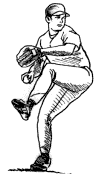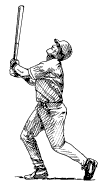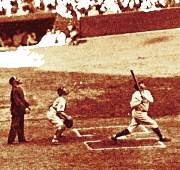hypertext narrative and baseball
The patterns and structures of hypertext narrative sometimes seem complex, and a few critics dismiss hypertext because it does not always fit into familiar dramatic structures. But hypertext's patterns are not confined to avant-garde experiments; the patterns that help us understand hypertext fiction are patterns we see in other large-scale narratives -- journalism, history, memoir, and technical writing.
 Farther afield from the friendly confines of literature, the narratives of sport are also large and complex. Perhaps the patterns of hypertext may seem less forbidding as we find them in the narratives of professional baseball. While pundits fret that television and new media somehow make the audience passive and inattentive, thoughtful observation reveals surprising scope and depth even in popular entertainment.
Farther afield from the friendly confines of literature, the narratives of sport are also large and complex. Perhaps the patterns of hypertext may seem less forbidding as we find them in the narratives of professional baseball. While pundits fret that television and new media somehow make the audience passive and inattentive, thoughtful observation reveals surprising scope and depth even in popular entertainment.
 Cycles are central to hypertext and to baseball. In hypertext fiction, the rhythms of recurrence created by intersecting link paths are perhaps the central feature.
Cycles are central to hypertext and to baseball. In hypertext fiction, the rhythms of recurrence created by intersecting link paths are perhaps the central feature.
Cycles pervade baseball. The game's rhythms create a host of cycles, large and small: the rotation of batters through the order, the rotation of starting pitchers through the week, the stately progress of opponents through the schedule, the annual race for the pennant which -- particularly for Cubs fans -- begins each year with a Spring of new hope, a Summer of struggle, an Autumn of resignation and faith. (The Cubs last won a pennant in 1946)
 My father took me to see Stan Musial and Ernie Banks, my grandmother was there when Ruth called his shot. |
While pundits claim that TV and computers have shortened and corrupted our attention spans, popular taste actually reflects an enormous appetite for narrative cycles of grand scale. The narrative of baseball spans seasons and decades. Fans watch their favorite players move from prospect to star to wily veteran, and relish the connections across time. This year, Dennis Eckersley returns to the Red Sox after many years' absence. When young, Eckersley faced Hank Aaron; Aaron, in turn, faced Bob Feller; Feller pitched to Rogers Hornsby, and Hornsby, in turn, dug in for the wicked curveballs of Three Finger Brown. My father took me to see Stan Musial and Ernie Banks, my grandmother was in the stands when Ruth called his shot. (None of my family has ever been a really serious fan)
"In counterpoint, two voices alternate, interleaving themes or welding together theme and response. Counterpoint often gives a clear sense of structure, a resonance of call and response reminiscent at once of liturgy and of casual dialogue." -- Mark Bernstein, Patterns of Hypertext, Hypertext '98
Counterpoint also pervades baseball. As the pitcher throws, the batter is swinging. As the batter swings, the baserunner takes off for second. The narrative of the pitcher's progress through the game -- early wildness, mid-game command, late-inning fatigue -- is interrupted every half-inning as his team comes to bat. At an even larger scale, every game is a chapter in at least two intersecting narratives. For the Mets, this game is a milestone in a late-season pennant race. For the Phillies, long out of the race, it may be the first crucial chapter in a rookie's stab at stardom.
The philosophical contrast between players has always ranked among the game's great attractions. Third baseman Kevin Mitchell, aging, undisciplined slugger trying to salvage his career, stands in and slaps an outside slider down the line to Scott Rolen, future Phillie phenom. Mantle uncorks a towering fly to center, but Mays, starting back at the crack of the back, takes it in stride.
To watch baseball well demands an eye for montage, for many things are always happening or about to happen. The pitcher eyes the runner leading off first, the runner edges away, the shortstop (or the second baseman) cheats toward second. The pitcher snaps a throw to first, the runner dives back, the third baseman moves to back up the return throw. Each move is scripted, each assignment rehearsed, yet each is almost infinitely variable. Montage, too, governs the sense of history that pervades the game. As we watch Troy O'Leary grab the rebound off Fenway's left-field wall and peg to second, we also see the shades of Greenwell, Rice, Yazstremski, and Ted Williams. Sitting in the bleachers -- the same bleachers from which Updike saw The Kid's farewell home run -- we turn to a nearby stranger and nod: not bad, not Yaz of course, but not too shabby.
The inner game, "inside baseball", is the domain of mirror worlds, of ephemeral possibilities and alternate realities. Should the manager yank a tiring pitcher or leave him in for another batter? Should we bring in a fresh reliever, or hope a tired veteran can last one more inning?
"Turn back the hands of time,
Give me the youth that once was mine:
Where the hell is Clem Labine?
Let's do it over again."
— Lament, on the occasion of the Miracle at Coogan's Bluff
Fans of classical tragedy -- that is, the followers of Brooklyn and Boston -- can conjure a host of tiny changes that alter everything. If Torrez bears down on weak-hitting Bucky Dent, if Bill Buckner can reach down just one more time, if Buckner can simply manage to fall down and stop the ball, decades of failure end in sudden joy. Moments like these, polished in memory, themselves form patterns, instantly recognizable by fans. Merkle's boner. The homer in the gloaming. Pesky holds the ball. The shot heard 'round the world. Mays' catch. The Sixth Game.
The inner game also gives us a wealth of navigational feints, quests pursued (or evaded) outside the game itself. The drama of the record book is part of the game -- otherwise it would be mere trivia -- but stands outside it; we may marvel at great accomplishments even in the context of terrible seasons. Ernie Banks winning the MVP (twice!) for the last-place Cubs, or Steve Carlton winning 27 while the Phils lost 98 of the other 134: these are dreams that sustain us through seasons that cannot possibly end well.
As I write this, the Red Sox and the Cubs are both in post-season play for the first time since 1918. Truly, reality (and even the tiny corner of it that is occupied by professional baseball) is a more strange and complex place than hypertext narrative.
